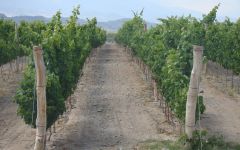Anko Flor de Cardon Malbec 2018
-
Wine
Spectator -
Wine
Enthusiast



Product Details
Your Rating
Somm Note
Winemaker Notes
A complex wine with concentrated fruit and mineral flavors.
Professional Ratings
-
Wine Spectator
Well-structured, with focused minerality to the red currant and dried raspberry flavors, supported by crunchy acidity. Hot stone accents show on the firmly tannic finish.
-
Wine Enthusiast
Aromas of dried earth, baking spice, wild berry and smoky plum are expansive on the nose, while it feels medium in weight on the palate. Baked black plum, oak spice and tomato flavors bring all the elements of high-altitude grapes into play. The finish is tight and dry, with berry flavors aided by oak spice and pepper. Vino Del Sol.
Other Vintages
2017-
James
Suckling
-
James
Suckling
-
James
Suckling -
Wine
Enthusiast
-
Wine &
Spirits -
Robert
Parker
-
Wine
Enthusiast
-
Wilfred
Wong -
Wine
Enthusiast






Celebrated for its bold flavors and supple texture, Malbec has enjoyed runaway success in Argentina since the late 20th century. The grape originated in Bordeaux, France, where it historically contributed color and tannin to blends. A French agronomist, who saw great potential for the variety in Mendoza’s hot, high-altitude landscape, brought Malbec to Argentina in 1868. Somm Secret—If you’re trying to please a crowd, Malbec is generally a safe bet with its combination of dense fruit and soft tannins.

The Salta region in northern Argentina is home to world’s highest vineyards. Near the town of Payogasta, the Colomé Altura Máxima vineyard is planted at 10,206 feet in elevation.
Salta is part of the Calchaquí Valley, which benefits from more than 300 days of sun per year, subjecting its vines to considerable ultraviolet radiation. The valley experiences strong high altitude winds, even in the “lower” vineyards, which are planted at 5,413 feet. Because of these elevations and resulting extreme conditions, vines produce lower yields and thicker-skinned grapes, resulting in concentrated, aromatic and well-structured wines.
In a truly unique region, the highly aromatic variety, Torrontes, thrives; intense sun exposure allows full ripening, while cooling winds maintain the grapes’ acidity levels and phenolic balance.
Malbec, Cabernet Sauvignon, Bonarda, Syrah, and, particularly, Tannat have the most potential among reds.
Upscale hotels, beautiful colonial architecture, a majestic Andean backdrop and impressive food and wine make the area attractive among tourists as well.
Salta is the fourth most important Argentine wine-producing region after Mendoza, San Juan, and La Rioja. Its oldest vineyards were planted in 1862.
